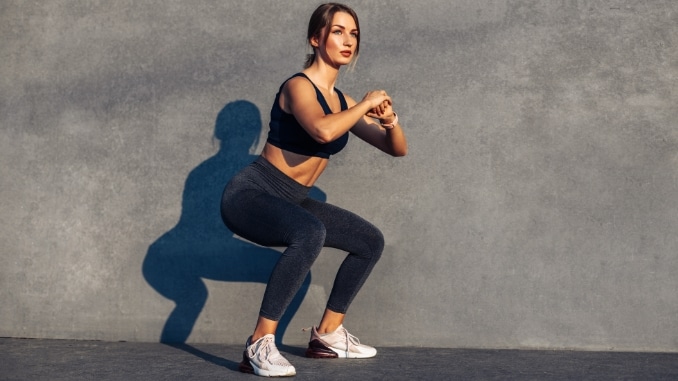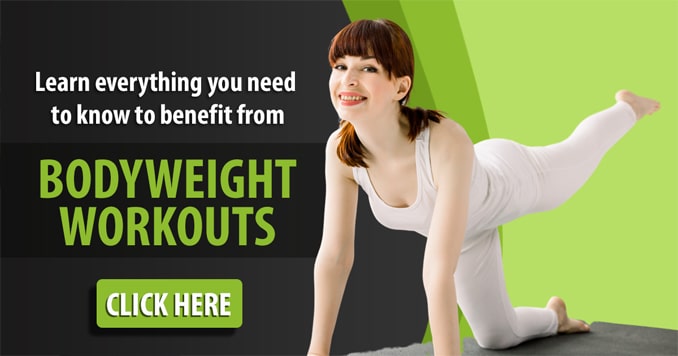In today's fast-paced world, it's essential to prioritize your health and fitness. However, not everyone has access to a gym or fancy equipment. A beginner bodyweight workout is the perfect solution if you're starting your fitness journey and want an effective way to get in shape without any expensive gear. This article will walk you through a comprehensive bodyweight workout routine to help you build strength, improve flexibility, and boost your overall fitness. Let's dive in!
Why Bodyweight Workouts are Perfect for Beginners
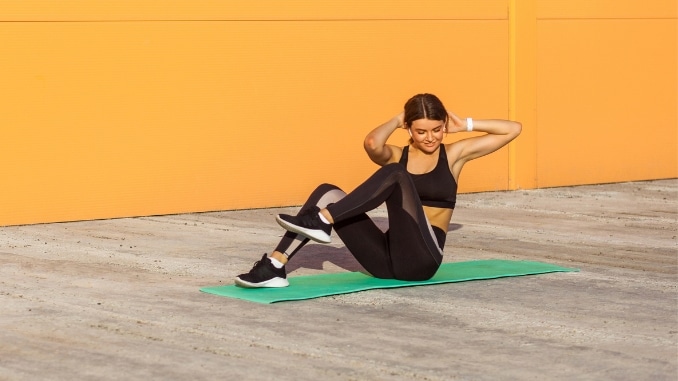
Determining where to begin can be overwhelming when starting a fitness journey. Many people think they need fancy equipment or a gym membership to get in shape, but that's not true. Bodyweight exercises are the perfect workout for beginners due to their convenience; they require no equipment, only utilize your body weight, and can be performed anywhere. One of the most significant advantages of bodyweight workouts is that they use your body as resistance.
This means you can control the intensity of each exercise based on your fitness level. Whether you're just starting or have been inactive for a while, bodyweight exercises can be modified to suit your needs. Additionally, bodyweight workouts engage multiple muscle groups simultaneously, providing a full-body workout. This helps improve overall strength, balance, and coordination. You'll build a solid foundation for future fitness endeavors by mastering the basics of bodyweight exercises.
Benefits of Bodyweight Workouts

Bodyweight workouts offer numerous benefits that make them an excellent choice for beginners. Firstly, they are highly accessible. Whether at home, on vacation, or even in a hotel room, you can perform bodyweight exercises without equipment. This eliminates the need to rely on external factors to stay active. Moreover, bodyweight workouts are functional. They mimic daily movements, such as pushing, pulling, and squatting.
Training these movements will improve your overall functional strength, making daily tasks easier and reducing the risk of injuries. Another advantage of bodyweight workouts is their ability to improve flexibility and mobility. Many bodyweight exercises require a full range of motion, which helps to increase joint flexibility and muscle elasticity. This can lead to better posture, reduced muscle imbalances, and improved athletic performance. Additionally, bodyweight workouts can be easily modified to suit your goals. Whether you want to focus on strength, endurance, or fat loss, countless bodyweight exercises and variations help you achieve your desired outcome.
Are Bodyweight Exercises as Good as Weights?
There are a few factors to consider regarding the debate between bodyweight exercises and weightlifting. Bodyweight exercises can be as good as weights for muscle building and overall fitness, especially for beginners. These exercises utilize the resistance of your body weight to build strength and improve muscular endurance.
Additionally, bodyweight workouts are versatile and can be done anywhere, making them convenient for those who may not have access to a gym or equipment. However, it is essential to note that weightlifting can allow for progressive overload by gradually increasing the weight lifted, which may lead to more significant muscle hypertrophy and strength gains in the long run. Ultimately, the effectiveness of bodyweight exercises versus weightlifting will depend on individual goals and preferences. Talking with a fitness professional to assess the best approach for your specific needs is always recommended.
The Science Behind Bodyweight Training
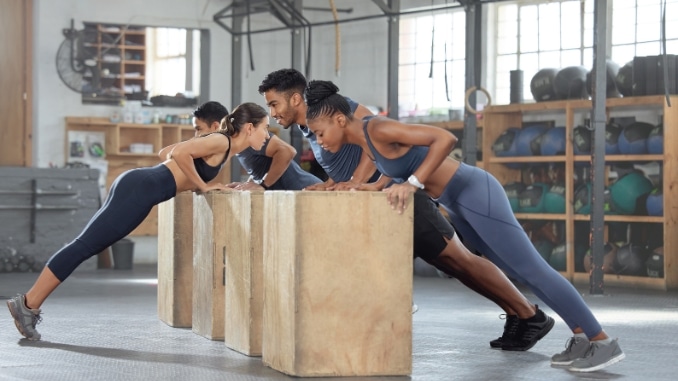
Bodyweight training is not just a trend; it is backed by science. Research shows bodyweight exercises can be as practical as traditional weight training for building strength and muscle mass. When you perform bodyweight exercises, your muscles are forced to work against gravity, increasing muscle fiber recruitment and activation. This, in turn, stimulates muscle growth and strength development.
Furthermore, bodyweight exercises often require stabilization, engaging your core and smaller stabilizer muscles. This improves your overall strength and enhances your balance and coordination. Studies have also shown that bodyweight training can improve cardiovascular fitness. High-intensity bodyweight workouts, such as circuit or interval training, can elevate your heart rate and improve your aerobic capacity. In summary, bodyweight training is a scientifically proven method for building strength, improving muscle mass, and enhancing overall fitness levels. It offers various benefits and can be tailored to individual goals and preferences.
Key Consideration Before Doing a Bodyweight Workout
Before starting a bodyweight workout, there are several key considerations to keep in mind to ensure safety, effectiveness, and a successful fitness routine. Here are some essential factors to consider:
- Health and Medical Conditions: Seek advice from a healthcare professional or a fitness expert if you possess any pre-existing medical conditions or injuries that could impact your capacity to engage in particular exercises. They can recommend which activities are suitable and secure for your circumstances.
- Goals and Objectives: Determine your fitness goals. Whether they involve weight loss, muscle gain, enhanced flexibility, or increased endurance will determine your chosen exercises and workout routines.
- Warm-Up and Cool-Down: Always start your workout, ensuring a thorough warm-up to ready your muscles and joints for the exercise ahead. Likewise, finish with a cool-down to gradually lower your heart rate and prevent injury.
- Proper Form and Technique: Focus on using each exercise's correct form and technique. Poor form can lead to injuries and reduce the effectiveness of the workout. Consider working with a fitness professional if you need more clarification on your form.
- Progression: Plan for advancement in your workouts. Gradually increase the intensity, duration, or complexity of exercises to avoid plateaus and continue making progress.
- Variety: Include a variety of exercises to target different muscle groups and prevent overuse injuries. Bodyweight exercises include squats, push-ups, planks, lunges, and more.
- Rest and Recovery: Give your body time to recover between workouts. Overtraining can lead to burnout and injuries. Aim for at least 48 hours of rest between working the same muscle group intensely.
- Nutrition and Hydration: Proper nutrition and hydration support your workouts and overall health. Ensure you're getting the necessary nutrients and staying hydrated.
- Space and Equipment: Determine where you'll be working out and whether you can access any necessary equipment. Bodyweight exercises can be executed with minimal equipment, yet the inclusion of having a clear space to exercise is essential.
- Consistency: Consistency is key to seeing results. Create a workout routine that you can realistically stick to, whether daily, several times a week, or weekly.
- Listen to Your Body: Pay attention to how your body feels during and after workouts. If you experience pain or discomfort beyond typical muscle soreness, it's essential to stop and seek guidance.
- Recovery and Rest Days: Incorporate rest days into your routine to allow your muscles and body to recover. These days are essential for preventing overtraining and promoting muscle growth.
- Progress Tracking: Keep track of your workouts and progress. This can help you stay motivated and make necessary adjustments to your routine.
- Safety: Ensure your workout area is safe and free from hazards. Clear any obstacles and use proper equipment, such as exercise mats, to prevent slips and injuries.
- Adaptability: Be prepared to adapt your workout routine as needed. Life can be unpredictable, so having alternative exercises or routines in mind can help you stay on track.
Warm-Ups:
1. Shoulder Rolls
Begin in an upright standing position with your feet shoulder-width apart, maintaining good alignment with your head, shoulders, hips, and legs. Engage your core. Lift your shoulders, then roll them down and back until you feel resistance in your shoulder blades. To intensify the movement, you can move your whole arms. Repeat the movement and complete 10 repetitions.
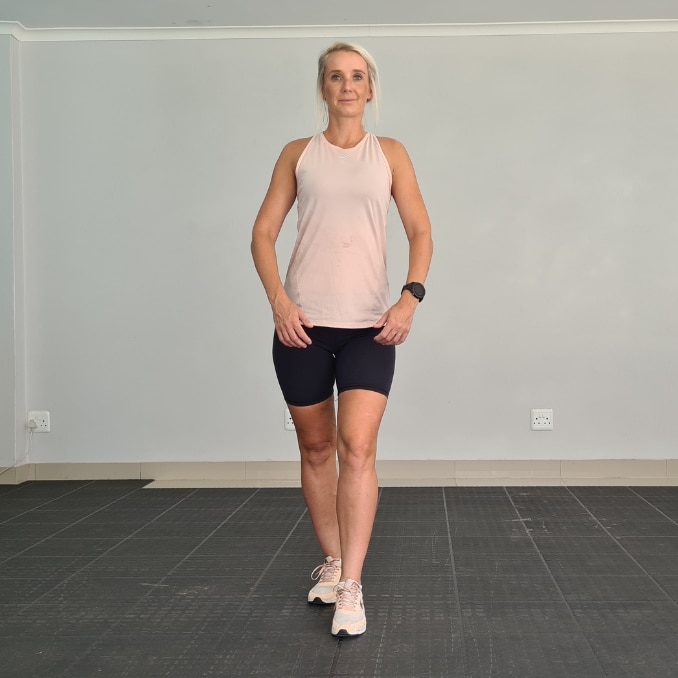 |
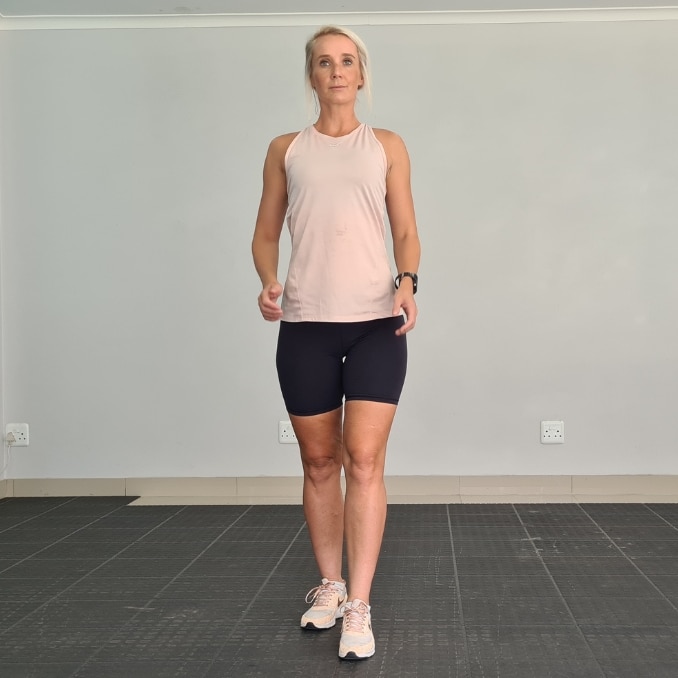 |
2. Shoulder Twist
Firstly, begin in an upright standing position with your feet hip-width apart, maintaining good alignment with your head, shoulders, hips, and legs. Secondly, place your hands on your shoulders. Engage your core, then twist your upper body to one side. Lastly, return to the starting position and repeat the movement on the opposite side. Complete 10 repetitions.
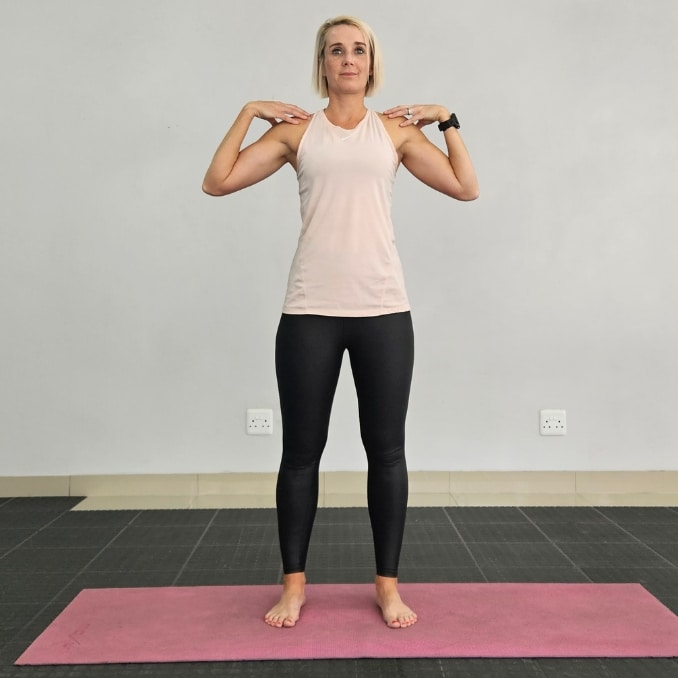 |
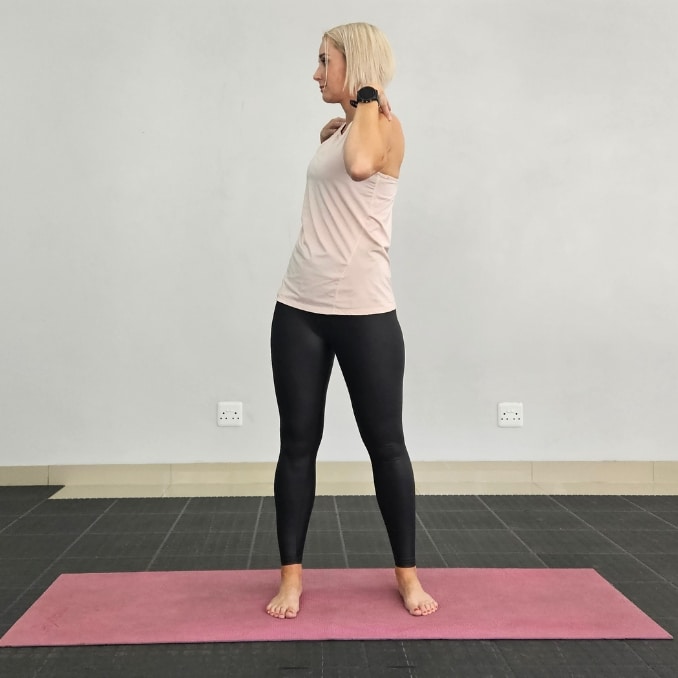 |
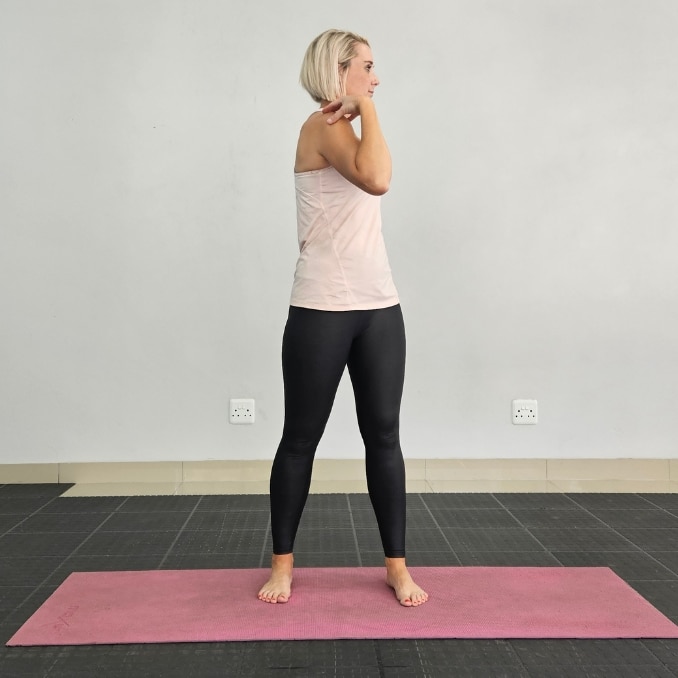 |
3. Side Reach
Begin in an upright standing position with your feet shoulder-width apart, maintaining good alignment with your head, shoulders, hips, and legs. Engage your core. Rotate your upper body to one side and reach across your body with one arm at chest height as you lift your opposite heel up. Return to the starting position and then repeat the movement on the opposite side. Start with 1 set of 5 repetitions on each side.
 |
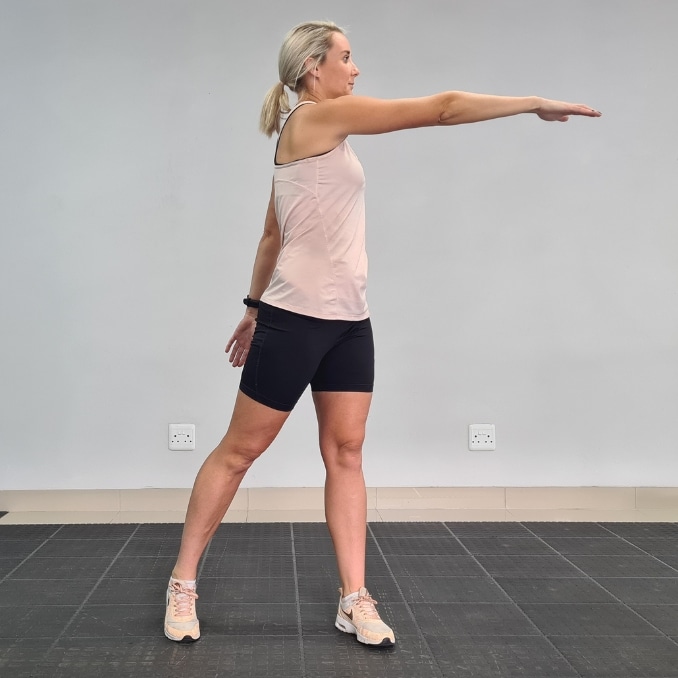 |
4. Single Arm Raise
Firstly, begin in an upright standing position with your feet shoulder-width apart, maintaining good alignment with your head, shoulders, hips, and legs. Place your arms at your sides. Secondly, engage your core and raise one arm overhead, maintaining a straight line with your body. Lastly, lower your arm to return to the starting position and repeat the movement on the opposite side. Complete 10 repetitions on each side.
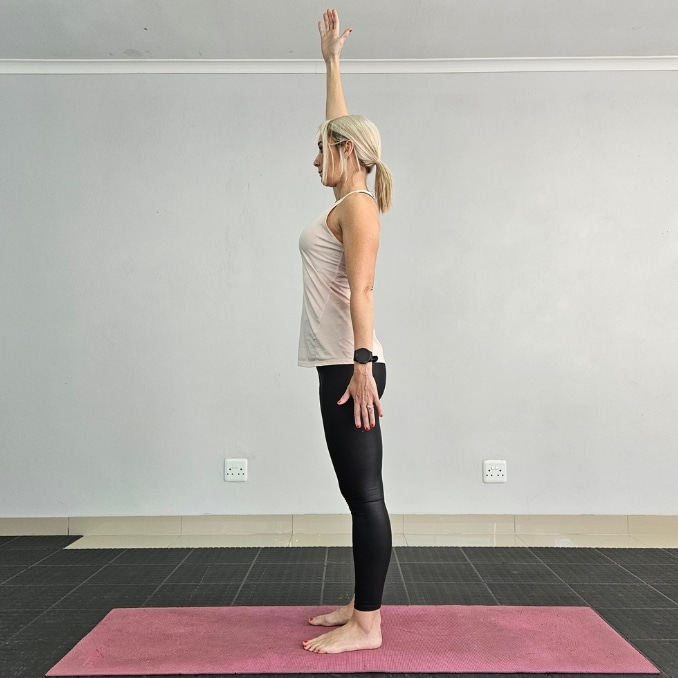 |
 |
5. Squat
Begin in an upright standing position with your feet hip-width apart, maintaining good alignment with your head, shoulders, hips, and legs. Bring your hands in front of your body at chest height. Engage your core, keep your knees bent, and then hinge through your hips to move into a squat position. Raise back to an upright standing position, squeezing your glutes at the top. Repeat the movement and complete 10 repetitions.
 |
 |
6. High Knee
Begin in an upright standing position with your feet hip-width apart, maintaining good alignment with your head, shoulders, hips, and legs. Engage your core. Drive one knee towards your chest as you counter the movement with your opposite arm. Return to the starting position and then repeat the movement on the opposite side. Complete with 3 sets of 10 repetitions on each side.
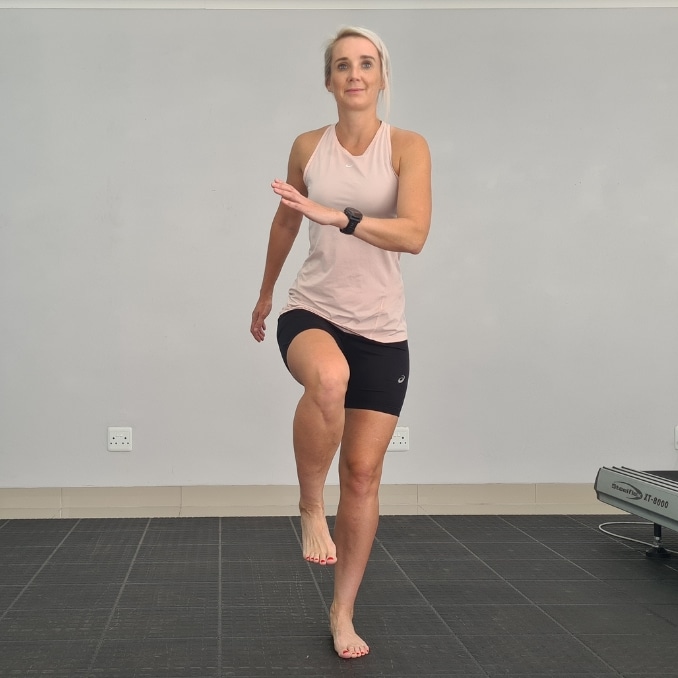 |
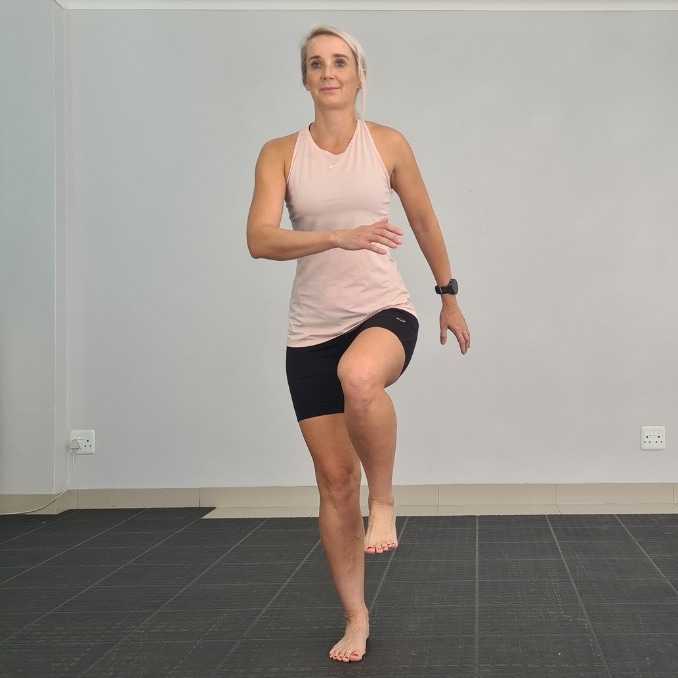 |
Best Beginner Bodyweight Workout
To start your beginner bodyweight workout, it's important to focus on mastering the essential exercises. These exercises will target major muscle groups and provide a solid foundation for more advanced movements. Here are some indispensable bodyweight exercises to include in your routine:
1. Low Squat
For this exercise, utilize the back of the chair or wall for support if needed.
Firstly, begin in an upright standing position with your feet hip-width apart, maintaining good alignment with your head, shoulders, hips, and legs. Secondly, place your hands on the back of the chair for support and balance if needed. Engage your core, bend your knees, and then hinge through your hips to move into a squat position. Lastly, raise back up to return to the starting position, squeezing your glutes at the top. Repeat the movement and then complete 3 sets for 10 repetitions.
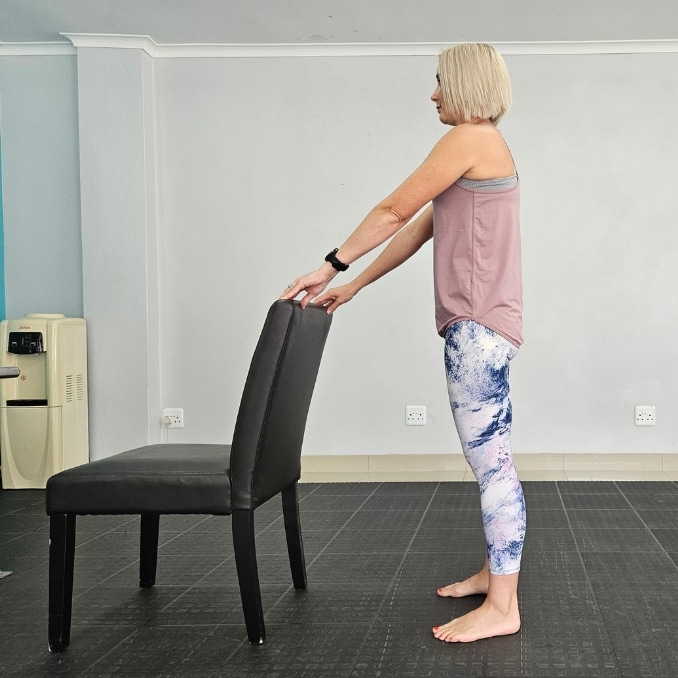 |
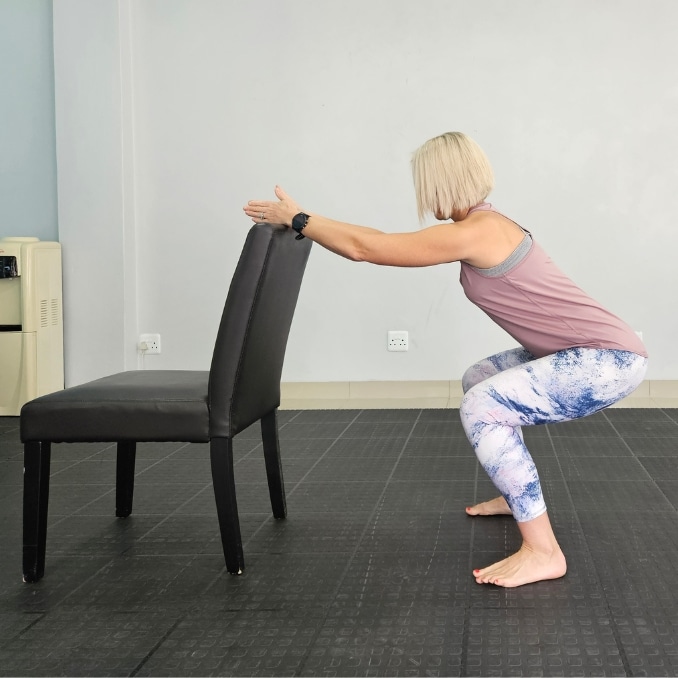 |
2. Marching-in-Place
Begin in an upright standing position with your feet shoulder-width apart, maintaining good alignment with your head, shoulders, and hips. Place your hands on your hips. Engage your core and then lift one knee up towards your chest. Return to the starting position and repeat the movement on the opposite side. Complete with three sets of 10 repetitions on each side.
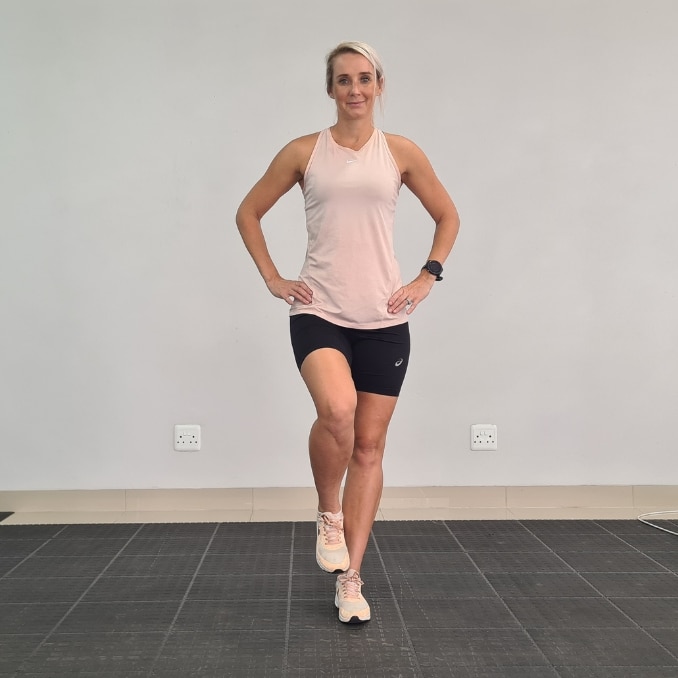 |
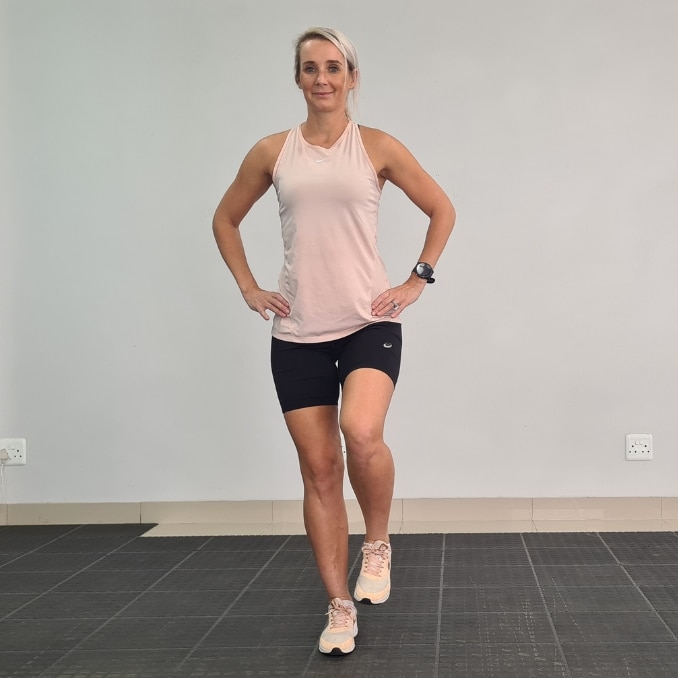 |
3. Single Leg Deadlift
For this beginner bodyweight workout, utilize the back of the chair or countertop for balance if needed.
Begin in an upright standing position with your feet shoulder-width apart, maintaining good alignment with your ears, shoulders, and hips. Engage your core and then transfer all of your weight onto your one foot. Slightly bend your supporting knee and hinge your hips, bending forward until your upper body is parallel to the floor while extending your opposite leg back. Return to the starting position and then repeat the movement. Complete 3 sets of 10 repetitions on each side.
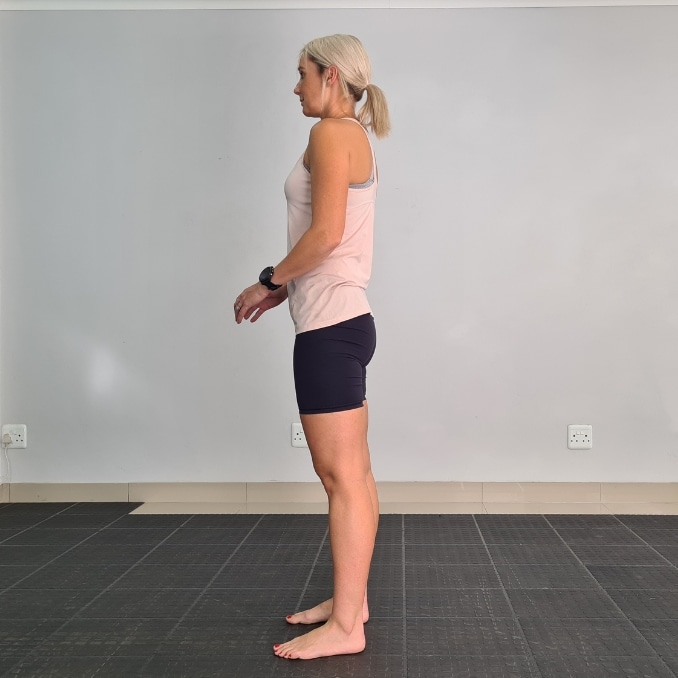 |
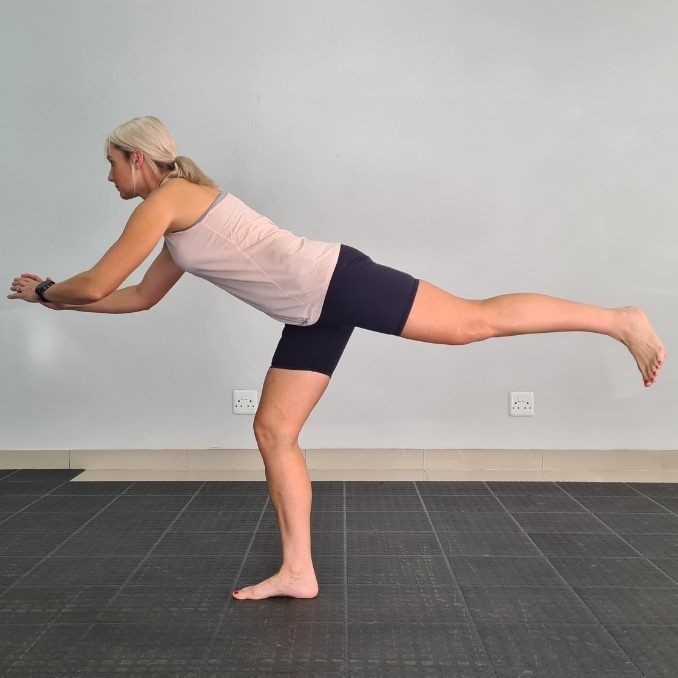 |
4. Side Steps
Begin in an upright standing position with your feet shoulder-width apart, maintaining good alignment with your head, shoulders, and hips. Engage your core and take a big step to the side with one foot, following with your other foot. Return to the starting position and then repeat the movement on the opposite side. Start with 3 sets of 10 repetitions on each side.
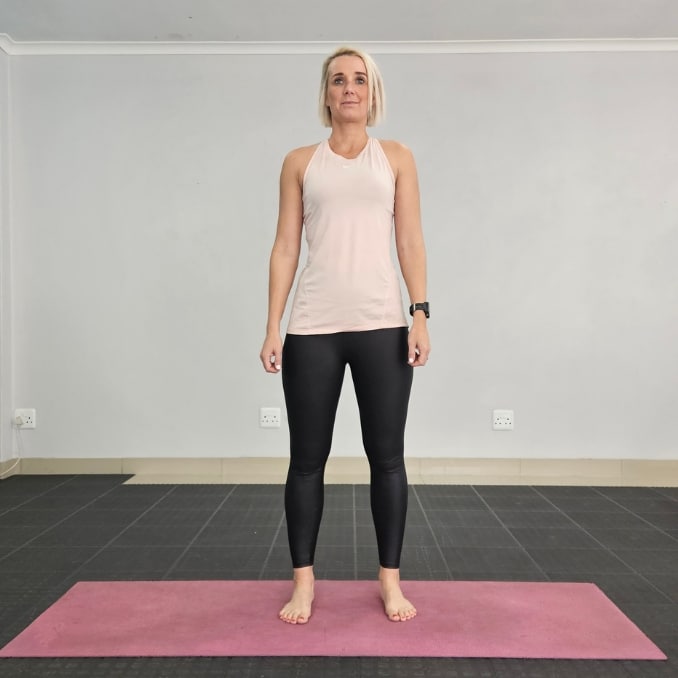 |
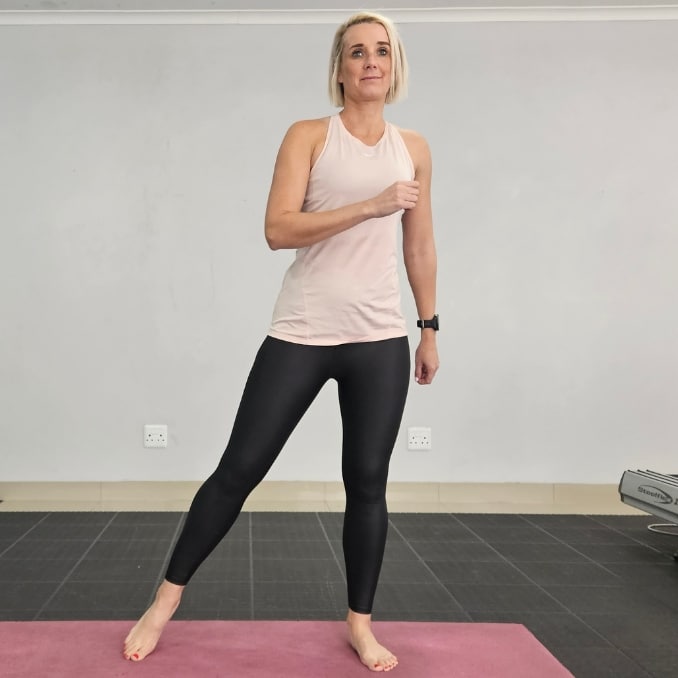 |
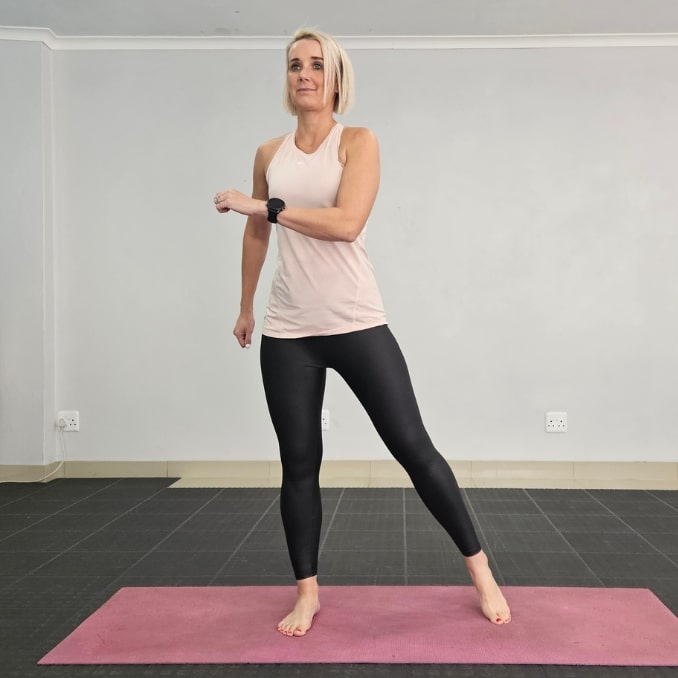 |
In addition, to intensify the movement, increase the speed, bend your knees, counter the movement with your opposite arm, or add a hopping movement.
5. Dynamic Upper Body Opener
Firstly, begin in an upright standing position with your feet hip-width apart, maintaining good alignment with your head, shoulders, hips, and legs. Reach forward with both hands shoulder-width apart at shoulder level. Secondly, engage your core, then pull your arms back with your elbows bent out to the sides, squeezing your shoulder blades together. Reach forward with both arms again, then bend your elbows to a 90-degree angle with your palms facing together. Thirdly, looking for a stretch through the chest and front of the shoulders, pull your arms back, squeezing your shoulder blades together. Lastly, return to the starting position and repeat the sequence of movements. Start with 1 set of 10 repetitions
This exercise targets major muscle groups and can be modified easily to suit your fitness level. Start with 2-3 sets of 10-12 repetitions for each activity, gradually increasing the intensity and speed.
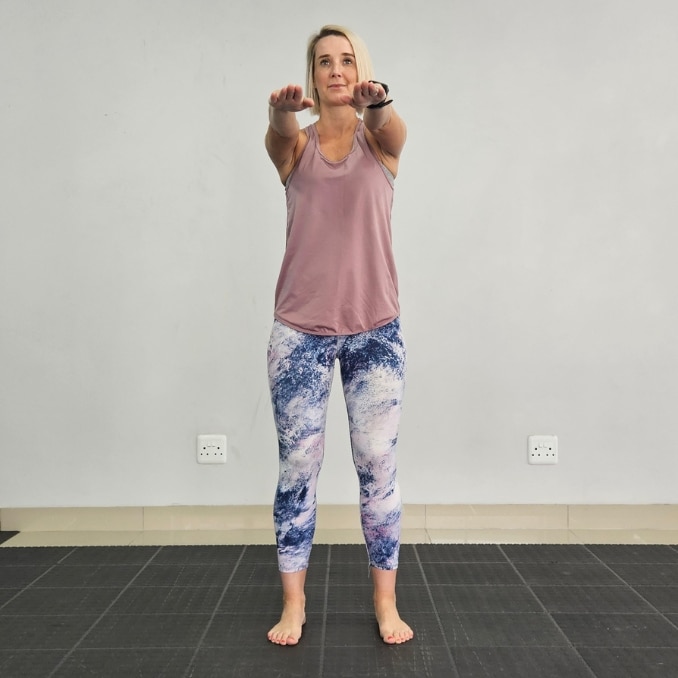 |
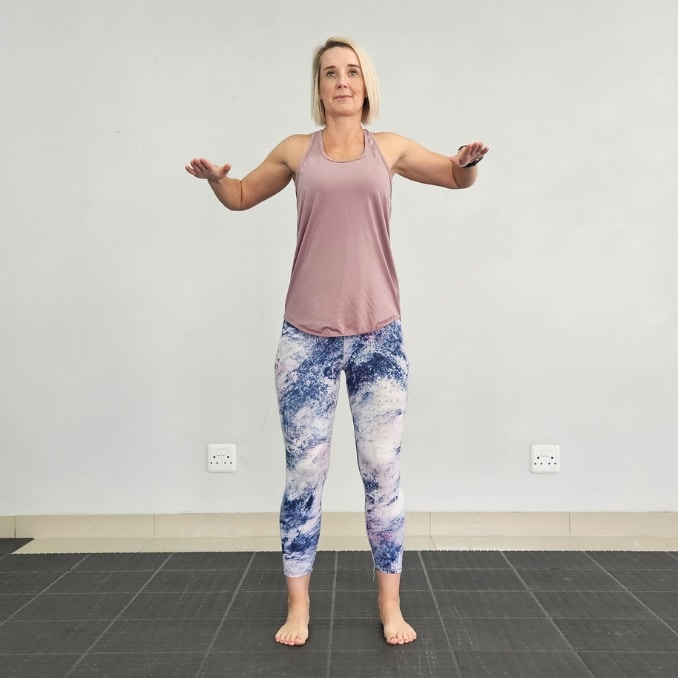 |
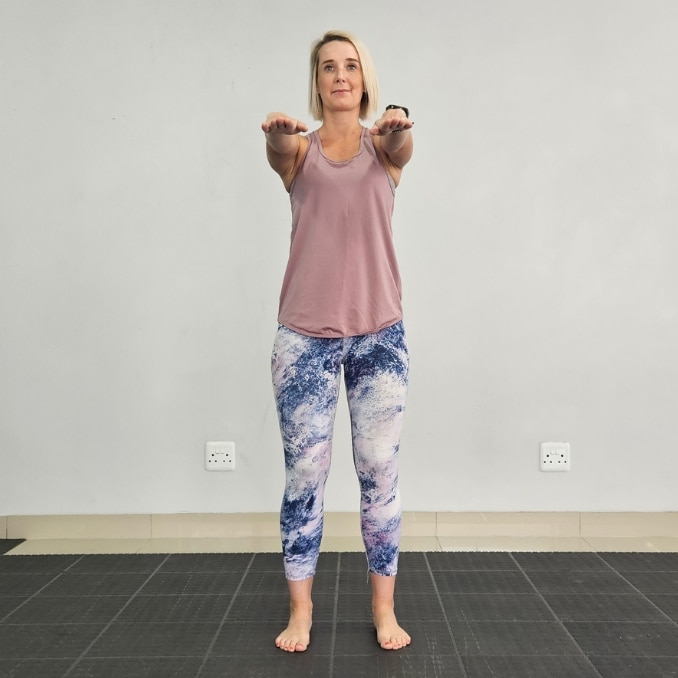 |
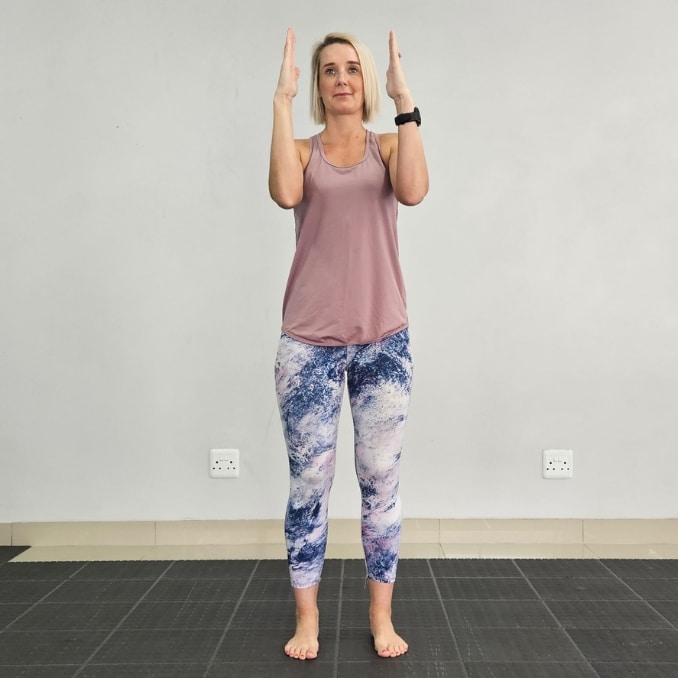 |
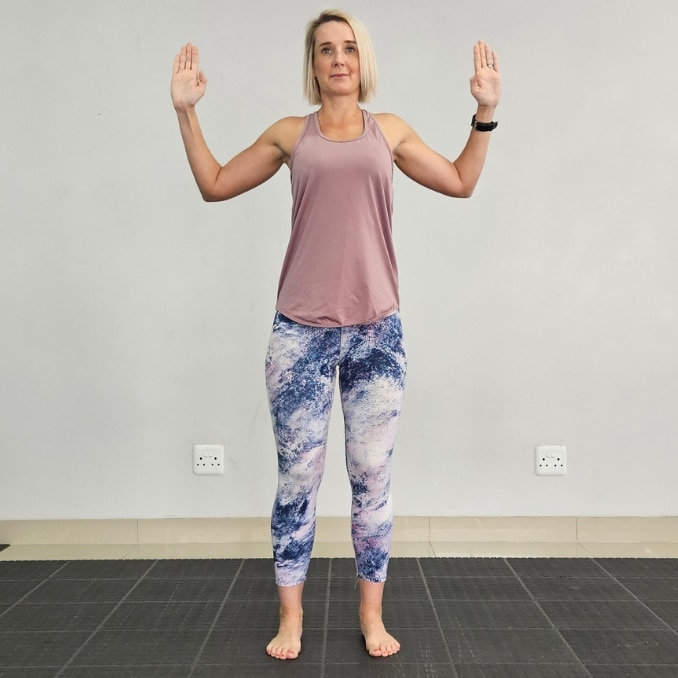 |
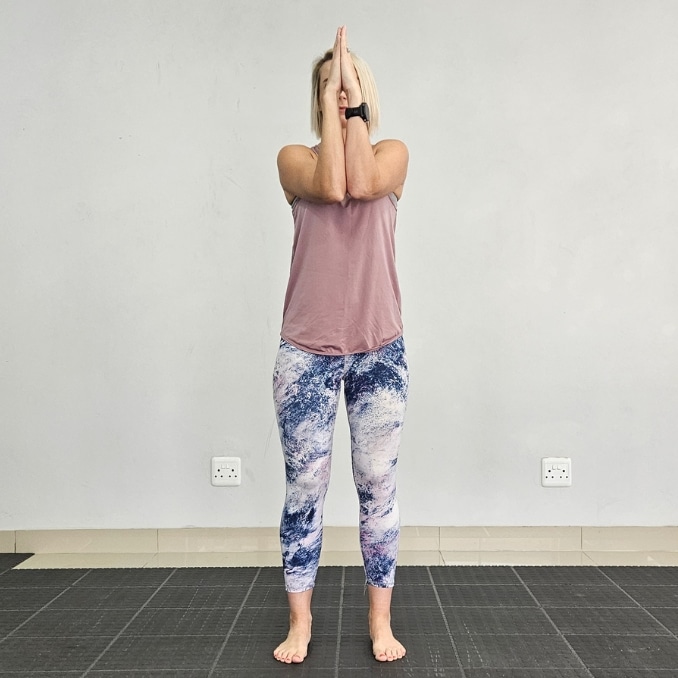 |
6. Elbow to Knee
For this beginner bodyweight workout, begin in an upright standing position with your feet shoulder-width apart, maintaining good alignment with your head, shoulders, hips, and legs. Engage your core. Twist your upper body to one side as you drive one knee up towards your chest, countering the movement with your opposite elbow. Return to the starting position and then repeat the movement on the opposite side. Start with 3 sets of 10 repetitions on each side.
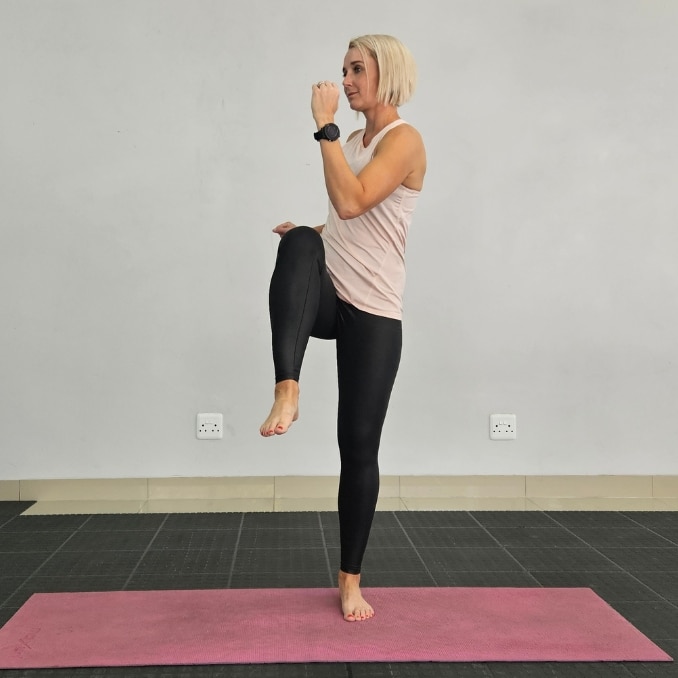 |
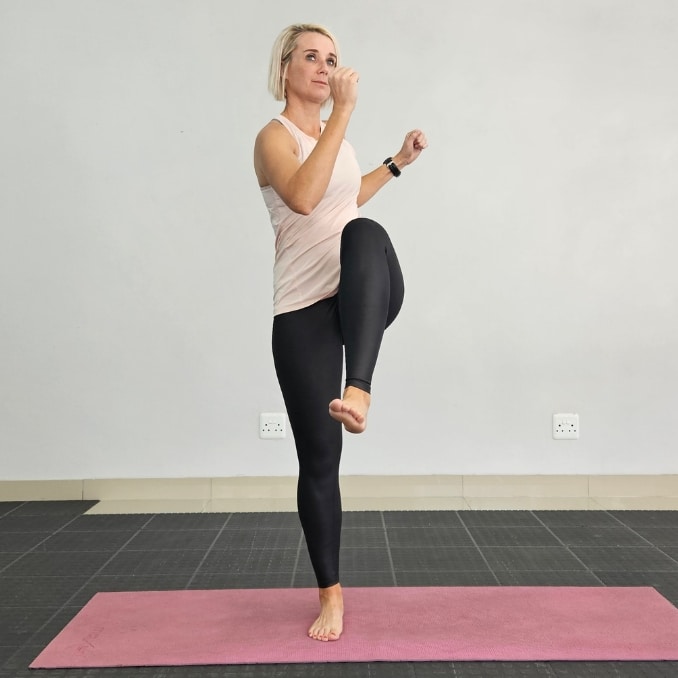 |
Cool Downs:
1. Back Stretch
Firstly, begin in an upright standing position with your feet shoulder-width apart, maintaining good alignment with your head, shoulders, hips, and legs. Secondly, place your hands on your lower back or upper pelvis area. Engage your core and then arch your back, focusing on the stretch happening in your low back area. Lastly, hold this position for several deep belly breaths through your nose and mouth. Relax and then repeat the movement.
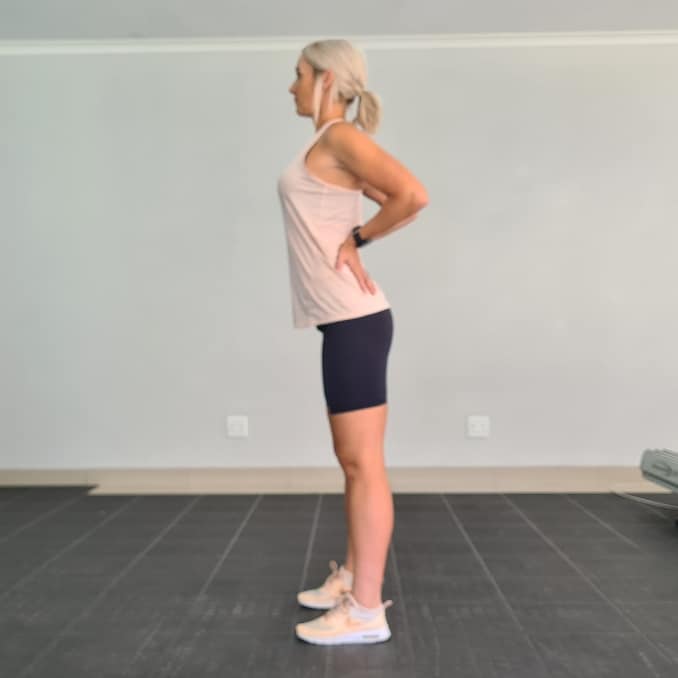
Variation 1- Back Stretch
Begin in an upright standing position with your feet shoulder-width apart, maintaining good alignment with your head, shoulders, hips, and legs. Slightly bend your knees and then place your hands on your knees. Engage your core and slowly round out your mid back as you drop your head towards your chest. Hold this position for several deep belly breaths through your nose and then mouth. Relax and repeat the movement.
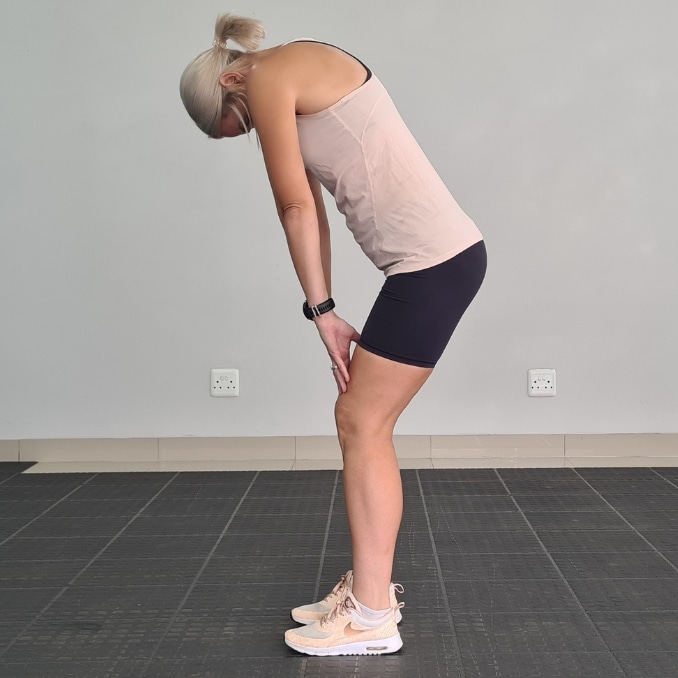
2. Standing Quad Stretch
For this beginner bodyweight workout, utilize the back of the chair, wall, or anything stable for balance and support if needed.
Begin in an upright standing position, maintaining good alignment with your head, shoulders, and hips. Place one hand on the back of the chair for balance if needed. Tighten your core, bring your heel up against your seat, and hold your foot with your hand. Hold this position for 5-10 seconds. Return to the starting position and then repeat the movement on the opposite side.
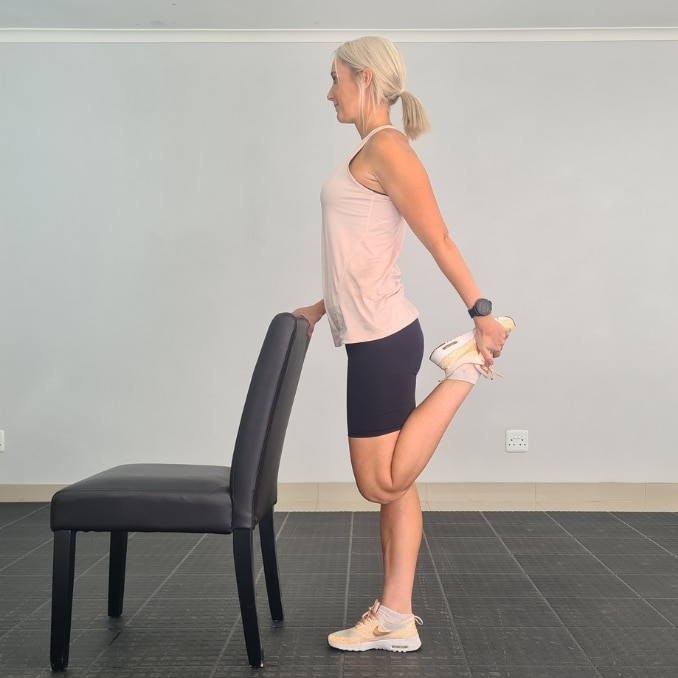
Structuring your Beginner Bodyweight Workout Routine
When structuring your beginner bodyweight workout routine, it's essential to consider your goals, fitness level, and available time. Here's a sample routine to help you get started:
1. Warm-up
Begin with 5-10 minutes of dynamic stretching or light cardio to raise your heart rate and warm up your muscles.
2. Main workout
Perform a circuit of the essential bodyweight exercises mentioned earlier. Start with 1-2 sets of each exercise, focusing on proper form and technique. Take short rest periods between workouts to maintain an elevated heart rate.
3. Cardiovascular exercise
Include 10-15 minutes of cardiovascular exercise, such as jumping jacks, jogging, or high knees, to improve your heart rate and endurance.
4. Cool-down
Finish your workout with static stretching to improve flexibility and promote muscle recovery.
Always pay attention to your body and adapt the intensity and duration of each exercise according to your current fitness level. As you progress, gradually increase the number of sets, repetitions, or difficulty of the activities to continue challenging your body.
Progressing in your Bodyweight Training
As you become more comfortable with your beginner bodyweight workout routine, you must keep challenging yourself to ensure continued progress. Here are some ways to progress in your bodyweight training:
- Increase intensity: Increase the difficulty of each exercise by adding variations or progressing from modified to full-range movements. For example, progress from knee push-ups to regular or assisted squats to pistol squats, targeting various muscle groups in your body, such as the bodyweight squats muscles worked.
- Add resistance: Incorporate resistance bands or weights to put an extra challenge to your bodyweight exercises. This can help increase muscle strength and stimulate further muscle growth.
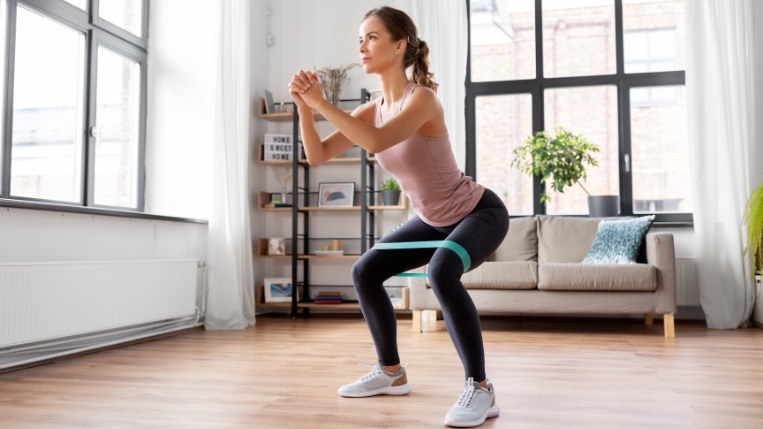
- Increase volume: Gradually increase the number of sets, repetitions, or workout duration to increase the overall workload. This will help improve muscular endurance and also cardiovascular fitness.
- Try advanced variations: Once you've mastered the basic bodyweight exercises, explore more advanced variations to challenge your body further. For example, try one-arm push–up position, pistol squats, or handstand push-ups.
You'll see improvements in strength, muscle tone, and overall fitness level by consistently progressing in your bodyweight training.
Common Mistakes to Avoid in Bodyweight Workouts
While bodyweight workouts are effective and accessible, there are some common mistakes that beginners often make. By being aware of these mistakes, you can ensure proper form and utilize the effectiveness of your perfect bodyweight workout. Here are some mistakes to avoid:
- Sacrificing form for quantity: It's important to prioritize proper form over the number of repetitions or sets. Focus on performing each exercise with controlled movements, maintaining good posture, and then engaging the correct muscles.
- Neglecting rest and recovery: Rest and recovery are crucial for muscle growth and injury prevention. Allow your body sufficient time to recover between workouts and avoid overtraining.
- Not progressing or challenging yourself: It's essential to challenge your body consistently to see progress. Gradually increase your workouts' intensity, volume, or difficulty to avoid plateauing.
- Ignoring flexibility and mobility: Flexibility and mobility are also essential for proper movement patterns and injury prevention. Integrate stretching and mobility exercises into your routine to improve your overall range of motion.
- Lack of variety: Repeating the same exercises can lead to boredom and decreased motivation. Explore different bodyweight exercises and variations to keep your workouts exciting and challenging.
Avoiding these common mistakes will ensure a safe and effective bodyweight workout routine that yields optimal results.
How to Stay Motivated in your Fitness Journey

Embarking on a fitness journey involves dedication and motivation. Here are some tips to help you stay motivated along the way:
- Set realistic goals: Specific, measurable, achievable, relevant, and time-bound (SMART). Having clear goals will provide you with direction and keep you motivated.
- Find a workout buddy: Exercising with a friend or joining a fitness community can provide accountability and support. Having a workout companion during workouts can add enjoyment to your fitness journey and assist in keeping you aligned with your goals.
- Track your progress: Keep a workout journal or use a fitness tracking app to record and track your workouts. Seeing how far you've come can be incredibly motivating.
- Reward yourself: Treat yourself with non-food rewards when you reach milestones or achieve your goals. This can help reinforce positive behaviors and keep you motivated.
- Mix it up: Avoid monotony by trying new exercises, workouts, or fitness classes. Keeping your workouts varied and exciting will prevent boredom and keep you engaged.
- Focus on non-scale victories: Instead of relying on the number on the scale, celebrate non-scale accomplishments such as increased strength, improved endurance, or better sleep quality. These achievements are equally important indicators of progress.
Motivation may fluctuate, but building healthy habits and a positive mindset will ultimately lead to long-term success on your fitness journey.
Beginner Bodyweight Workout Equipment and Accessories

One of the advantages of bodyweight workouts is that they require little to no equipment. However, a few accessories can enhance your workouts and make them more enjoyable. Here are some beginner-friendly equipment and accessories:
- Yoga mat: A yoga mat provides cushioning and grip, making floor exercises more comfortable and safe.
- Resistance bands: Resistance bands add an extra challenge to your bodyweight exercises by providing external resistance. They come in different resistance levels, allowing you to increase your workouts' intensity progressively.
- Jump rope: Jumping rope is a well-known cardiovascular exercise easily incorporated into your bodyweight workout routine. It helps improve coordination, endurance, and calorie burning.
- Pull-up bar: If you can access a pull-up bar, it can be a great addition to your bodyweight workouts. Pull-ups and chin-ups are compound exercises that target multiple upper-body muscles.
- Fitness app or tracker: A fitness app or tracker can help you stay organized, track your workouts, and monitor your progress. Many apps also provide workout routines and instructional videos for bodyweight exercises.
While these accessories are unnecessary, they can add variety and challenge to your workouts, making them more enjoyable and effective.
Conclusion:
Embarking on a fitness journey can be difficult, but with a beginner bodyweight workout, you can start on the right track. Bodyweight exercises are accessible, effective, and can be done anywhere. They offer numerous benefits, such as improved strength, flexibility, and overall fitness.
By mastering essential bodyweight exercises, structuring your workouts, and progressing over time, you'll continue to see improvements in your fitness level. Avoid common mistakes, stay motivated, and consider incorporating equipment and accessories to enhance your workouts.
Keep in mind that your fitness journey is entirely your own. Relish the journey, acknowledge small achievements, and welcome the positive transformations from prioritizing your health and well-being. Begin the initial step towards a healthier, more robust version of yourself today!
Bodyweight workouts are ideal for those who exercise at home, as they require no equipment and very little space, but are still incredibly impactful for increasing your cardio, building strength and improving flexibility. Check out this Bodyweight Workouts 101 now!

